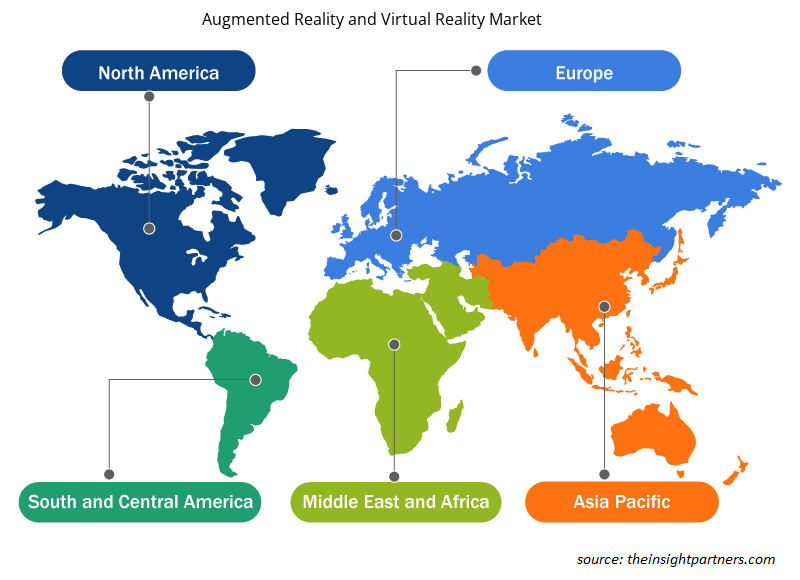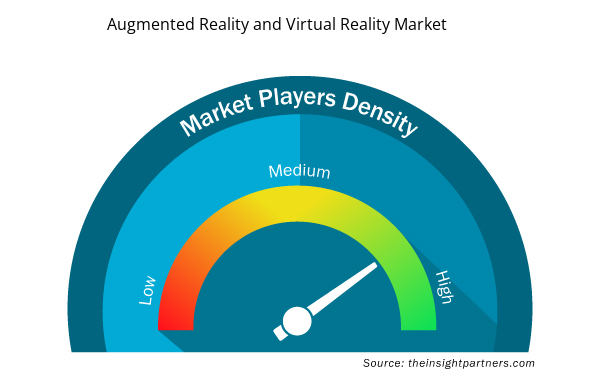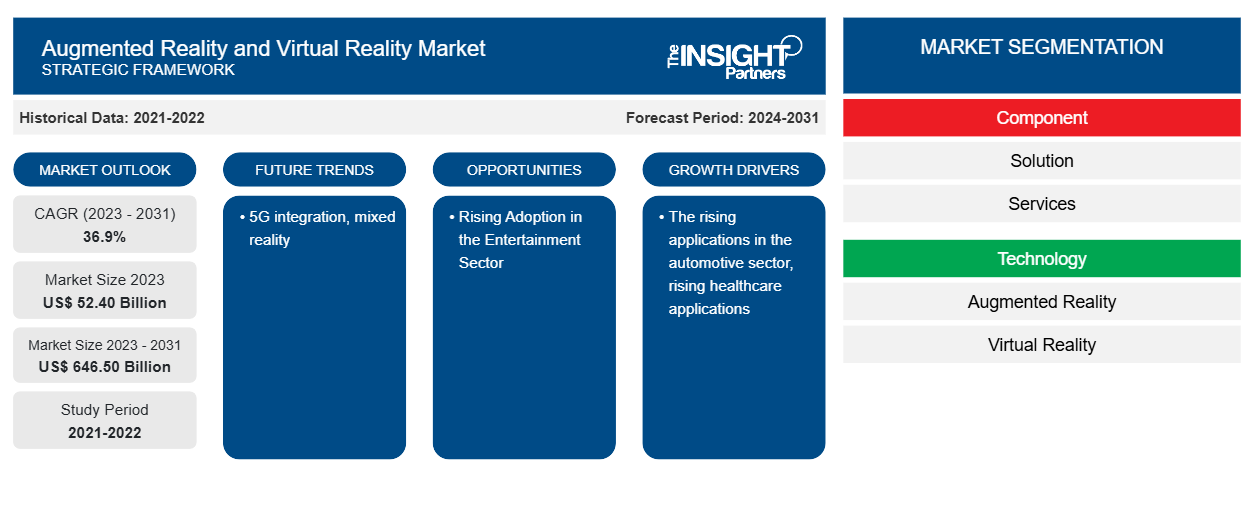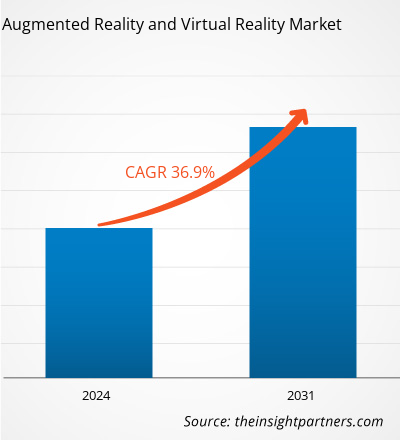Das Marktvolumen für Augmented Reality und Virtual Reality soll von 52,40 Milliarden US-Dollar im Jahr 2023 auf 646,50 Milliarden US-Dollar im Jahr 2031 anwachsen. Für den Zeitraum 2023–2031 wird ein durchschnittliches jährliches Wachstum von 36,9 % erwartet. 5G-Integration und Mixed Reality dürften weiterhin wichtige Trends auf dem Markt bleiben.
Augmented Reality und Virtual Reality Marktanalyse
AR- und VR-Technologie bieten zahlreiche einzigartige Möglichkeiten für neue und etablierte Unternehmen und den Handel. AR-Technologie ermöglicht es Menschen in zahlreichen Berufen, computergenerierte Grafiken in ihrem Sichtfeld zu sehen. Beide Technologien werden in zahlreichen Branchen eingesetzt, darunter Gesundheitswesen, Medien, Gas und Öl, Tourismus, Bildung, Gaming, Unterhaltung, Militär, Marketing, E-Commerce und Einzelhandel.
Augmented Reality und Virtual Reality Marktübersicht
Die globale AR- und VR-Branche erlebt aufgrund der gestiegenen Nachfrage nach Mobilgeräten und F&E-Investitionen ein rasantes Wachstum. Aufgrund der hohen Kosten und der visuellen Wirkung ist die AR/VR-Technologie im Vergleich zu anderen Verbrauchergeräten nur schwach gefragt und wird kaum angenommen. Führende multinationale Technologieunternehmen investieren in VR/AR-Forschung und -Entwicklung, um die Technologie voranzutreiben.
Passen Sie diesen Bericht Ihren Anforderungen an
Sie erhalten kostenlos individuelle Anpassungen an jedem Bericht, einschließlich Teilen dieses Berichts oder einer Analyse auf Länderebene, eines Excel-Datenpakets sowie tolle Angebote und Rabatte für Start-ups und Universitäten.
- Holen Sie sich die wichtigsten Markttrends aus diesem Bericht.Dieses KOSTENLOSE Beispiel umfasst eine Datenanalyse von Markttrends bis hin zu Schätzungen und Prognosen.
Treiber und Chancen auf dem Augmented Reality- und Virtual Reality-Markt
Die steigenden Anwendungen im Automobilsektor begünstigen den Markt
AR/VR wird in der Automobilindustrie aufgrund der zahlreichen Anwendungen und Vorteile, die es bietet, zunehmend zum Standard. Es vereinfacht und verbessert den Fahrzeugkauf und das Fahrerlebnis für alle Beteiligten. Die Automobilindustrie setzt AR/VR aggressiv ein, um das Fahr- und Urlaubserlebnis zu verbessern. Tatsächlich hat der Automobilsektor von allen großen Sektoren am meisten in AR- und VR-Technologien investiert. Einige Schwergewichte der Branche wie Porsche, Chrysler, Hyundai, Mitsubishi und Tesla haben die beiden Technologien bereits in verschiedene Phasen der Fahrzeugproduktion, des Marketings und des Verkaufs integriert. Dies treibt die Nachfrage auf dem Markt für Augmented Reality und Virtual Reality an.
Steigende Akzeptanz im Unterhaltungssektor
Der Virtual-Reality-Unterhaltungssektor hat die Art und Weise, wie Verbraucher Medien konsumieren, erheblich beeinflusst und einen Paradigmenwechsel in allen Bereichen ausgelöst, von Videospielen über Filme und Live-Shows bis hin zu Erlebnissen in Vergnügungsparks. Die VR/AR-Technologie (Virtual Reality/Augmented Reality) beginnt bereits, sich auf Rundfunk- und Streaming-Medien auszuwirken. VR/AR-Rundfunk und -Streaming können den Zuschauern ein vollständig immersives Erlebnis bieten und ihnen ermöglichen, auf neue und faszinierende Weise mit dem Material zu interagieren. Diese Technologie kann genutzt werden, um fesselnde Erlebnisse wie 360-Grad-Filme, interaktive Sportübertragungen, Virtual-Reality-Musikveranstaltungen und vieles mehr zu produzieren.
Augmented Reality und Virtual Reality Marktbericht Segmentierungsanalyse
Wichtige Segmente, die zur Ableitung der Marktanalyse für Augmented Reality und Virtual Reality beigetragen haben, sind die Technologie-, Komponenten- und Endbenutzerindustrie.
- Basierend auf der Technologie ist der Augmented-Reality- und Virtual-Reality-Markt in Augmented Reality und Virtual Reality unterteilt. Das Augmented-Reality-Segment hatte im Jahr 2023 einen größeren Marktanteil.
- Nach Komponenten ist der Markt in direkte Halbleiterkomponenten, Sensoren und Sonstiges segmentiert.
- Nach Endverbraucherbranche ist der Markt in die Bereiche Unterhaltung, Bildung, Industrie, Medizin, Immobilien und Architektur, Einzelhandel, Luft- und Raumfahrt und Verteidigung und Sonstige unterteilt.
Augmented Reality und Virtual Reality Marktanteilsanalyse nach Geografie
Der geografische Umfang des Marktberichts für Augmented Reality und Virtual Reality ist hauptsächlich in fünf Regionen unterteilt: Nordamerika, Asien-Pazifik, Europa, Naher Osten und Afrika sowie Süd- und Mittelamerika.
Nordamerika dominierte 2023 den Marktanteil im Bereich Augmented Reality und Virtual Reality. Die Region umfasst Länder wie die USA und Kanada, die technologisch weit fortgeschritten sind. Die Startup-Landschaft in den USA entwickelt sich kontinuierlich weiter, wobei aufstrebende Akteure Durchbrüche bei hochmodernen AR- und VR-Technologien erzielen.
Regionale Einblicke in den Augmented Reality- und Virtual Reality-Markt
Die regionalen Trends und Faktoren, die den Augmented Reality- und Virtual Reality-Markt während des Prognosezeitraums beeinflussen, wurden von den Analysten von Insight Partners ausführlich erläutert. In diesem Abschnitt werden auch Augmented Reality- und Virtual Reality-Marktsegmente und die Geografie in Nordamerika, Europa, im asiatisch-pazifischen Raum, im Nahen Osten und Afrika sowie in Süd- und Mittelamerika erörtert.

- Erhalten Sie regionale Daten zum Augmented Reality- und Virtual Reality-Markt
Umfang des Marktberichts zu Augmented Reality und Virtual Reality
| Berichtsattribut | Details |
|---|---|
| Marktgröße im Jahr 2023 | 52,40 Milliarden US-Dollar |
| Marktgröße bis 2031 | 646,50 Milliarden US-Dollar |
| Globale CAGR (2023 - 2031) | 36,9 % |
| Historische Daten | 2021-2022 |
| Prognosezeitraum | 2024–2031 |
| Abgedeckte Segmente | Nach Komponente
|
| Abgedeckte Regionen und Länder | Nordamerika
|
| Marktführer und wichtige Unternehmensprofile |
|
Dichte der Marktteilnehmer für Augmented Reality und Virtual Reality: Die Auswirkungen auf die Geschäftsdynamik verstehen
Der Markt für Augmented Reality und Virtual Reality wächst rasant. Die Nachfrage der Endnutzer steigt aufgrund von Faktoren wie sich entwickelnden Verbraucherpräferenzen, technologischen Fortschritten und einem größeren Bewusstsein für die Vorteile des Produkts. Mit der steigenden Nachfrage erweitern Unternehmen ihr Angebot, entwickeln Innovationen, um die Bedürfnisse der Verbraucher zu erfüllen, und nutzen neue Trends, was das Marktwachstum weiter ankurbelt.
Die Marktteilnehmerdichte bezieht sich auf die Verteilung der Firmen oder Unternehmen, die in einem bestimmten Markt oder einer bestimmten Branche tätig sind. Sie gibt an, wie viele Wettbewerber (Marktteilnehmer) in einem bestimmten Marktraum im Verhältnis zu seiner Größe oder seinem gesamten Marktwert präsent sind.
Die wichtigsten Unternehmen auf dem Augmented Reality- und Virtual Reality-Markt sind:
- Immersiver Blick
- Google LLC
- EON Realität
- Vuzix Corporation
- Blippar Group Limited (Layar BV)
- Innovega Inc.
Haftungsausschluss : Die oben aufgeführten Unternehmen sind nicht in einer bestimmten Reihenfolge aufgeführt.

- Erhalten Sie einen Überblick über die wichtigsten Akteure auf dem Augmented Reality- und Virtual Reality-Markt
Augmented Reality und Virtual Reality – Marktnachrichten und aktuelle Entwicklungen
Der Augmented-Reality- und Virtual-Reality-Markt wird durch die Erhebung qualitativer und quantitativer Daten nach Primär- und Sekundärforschung bewertet, die wichtige Unternehmensveröffentlichungen, Verbandsdaten und Datenbanken umfasst. Nachfolgend sind einige der Entwicklungen auf dem Augmented-Reality- und Virtual-Reality-Markt aufgeführt:
- EON Reality gibt stolz die Eröffnung des ersten Spatial AI Center auf den Marshallinseln bekannt. Diese zentrale Initiative soll den Ansatz der Inseln in Bezug auf Bildung, Gesundheitsversorgung und Klimaresilienz verändern und immersive Technologien einsetzen, um fortschrittliche Lernerfahrungen und nachhaltige Entwicklung voranzutreiben. (Quelle: EON Reality, Pressemitteilung, April 2024)
- Vuzix® Corporation (NASDAQ: VUZI) gab bekannt, dass sie neue Zusatzaufträge von zwei Luft- und Raumfahrt- sowie Verteidigungsunternehmen erhalten hat, um im Jahr 2024 wellenleiterbasierte Displaylösungen weiterzuentwickeln und bereitzustellen. (Quelle: Vuzix Corporation, Pressemitteilung, April 2024)
Marktbericht zu Augmented Reality und Virtual Reality – Abdeckung und Ergebnisse
Der Bericht „Marktgröße und Prognose für Augmented Reality und Virtual Reality (2021–2031)“ bietet eine detaillierte Analyse des Marktes, die die folgenden Bereiche abdeckt:
- Augmented Reality und Virtual Reality Marktgröße und Prognose auf globaler, regionaler und Länderebene für alle wichtigen Marktsegmente, die im Rahmen des Berichts abgedeckt sind
- Markttrends für Augmented Reality und Virtual Reality sowie Marktdynamiken wie Treiber, Einschränkungen und wichtige Chancen
- Detaillierte PEST/Porters Five Forces- und SWOT-Analyse
- Marktanalyse für Augmented Reality und Virtual Reality mit Blick auf wichtige Markttrends, globale und regionale Rahmenbedingungen, wichtige Akteure, Vorschriften und aktuelle Marktentwicklungen
- Branchenlandschaft und Wettbewerbsanalyse, einschließlich Marktkonzentration, Heatmap-Analyse, prominenten Akteuren und aktuellen Entwicklungen für den Augmented-Reality- und Virtual-Reality-Markt
- Detaillierte Firmenprofile
- Historische Analyse (2 Jahre), Basisjahr, Prognose (7 Jahre) mit CAGR
- PEST- und SWOT-Analyse
- Marktgröße Wert/Volumen – Global, Regional, Land
- Branche und Wettbewerbsumfeld
- Excel-Datensatz


- Adaptive Traffic Control System Market
- Underwater Connector Market
- Medical Collagen Market
- Electronic Signature Software Market
- Smart Parking Market
- Antibiotics Market
- Electronic Data Interchange Market
- Industrial Inkjet Printers Market
- Rugged Phones Market
- Airport Runway FOD Detection Systems Market

Report Coverage
Revenue forecast, Company Analysis, Industry landscape, Growth factors, and Trends

Segment Covered
This text is related
to segments covered.

Regional Scope
North America, Europe, Asia Pacific, Middle East & Africa, South & Central America

Country Scope
This text is related
to country scope.
Häufig gestellte Fragen
North America dominated the augmented reality and virtual reality market in 2023.
The rising applications in the automotive sector and rising healthcare applications are expected to drive the augmented reality and virtual reality market.
5G integration and mixed reality are likely to remain key trends in the market.
Immersive Gaze, Google LLC, EON Reality, Vuzix Corporation, Blippar Group Limited (Layar B V), Innovega Inc., imulanis Solutions Private Limited, Kanda ApS, YeppAR, Groove Jones, Quytech, The Intellify, Niantec, Microsoft, Apple, VironIT, Appricotsoft, Varwin, Monkhub Innovations are among the leading payers operating in the augmented reality and virtual reality market.
The augmented reality and virtual reality market size is projected to reach US$ 646.40 billion by 2031
The augmented reality and virtual reality market is expected to register a CAGR of 36.9% during 2023–2031
Trends and growth analysis reports related to Electronics and Semiconductor : READ MORE..
The Insight Partners performs research in 4 major stages: Data Collection & Secondary Research, Primary Research, Data Analysis and Data Triangulation & Final Review.
- Data Collection and Secondary Research:
As a market research and consulting firm operating from a decade, we have published and advised several client across the globe. First step for any study will start with an assessment of currently available data and insights from existing reports. Further, historical and current market information is collected from Investor Presentations, Annual Reports, SEC Filings, etc., and other information related to company’s performance and market positioning are gathered from Paid Databases (Factiva, Hoovers, and Reuters) and various other publications available in public domain.
Several associations trade associates, technical forums, institutes, societies and organization are accessed to gain technical as well as market related insights through their publications such as research papers, blogs and press releases related to the studies are referred to get cues about the market. Further, white papers, journals, magazines, and other news articles published in last 3 years are scrutinized and analyzed to understand the current market trends.
- Primary Research:
The primarily interview analysis comprise of data obtained from industry participants interview and answers to survey questions gathered by in-house primary team.
For primary research, interviews are conducted with industry experts/CEOs/Marketing Managers/VPs/Subject Matter Experts from both demand and supply side to get a 360-degree view of the market. The primary team conducts several interviews based on the complexity of the markets to understand the various market trends and dynamics which makes research more credible and precise.
A typical research interview fulfils the following functions:
- Provides first-hand information on the market size, market trends, growth trends, competitive landscape, and outlook
- Validates and strengthens in-house secondary research findings
- Develops the analysis team’s expertise and market understanding
Primary research involves email interactions and telephone interviews for each market, category, segment, and sub-segment across geographies. The participants who typically take part in such a process include, but are not limited to:
- Industry participants: VPs, business development managers, market intelligence managers and national sales managers
- Outside experts: Valuation experts, research analysts and key opinion leaders specializing in the electronics and semiconductor industry.
Below is the breakup of our primary respondents by company, designation, and region:

Once we receive the confirmation from primary research sources or primary respondents, we finalize the base year market estimation and forecast the data as per the macroeconomic and microeconomic factors assessed during data collection.
- Data Analysis:
Once data is validated through both secondary as well as primary respondents, we finalize the market estimations by hypothesis formulation and factor analysis at regional and country level.
- Macro-Economic Factor Analysis:
We analyse macroeconomic indicators such the gross domestic product (GDP), increase in the demand for goods and services across industries, technological advancement, regional economic growth, governmental policies, the influence of COVID-19, PEST analysis, and other aspects. This analysis aids in setting benchmarks for various nations/regions and approximating market splits. Additionally, the general trend of the aforementioned components aid in determining the market's development possibilities.
- Country Level Data:
Various factors that are especially aligned to the country are taken into account to determine the market size for a certain area and country, including the presence of vendors, such as headquarters and offices, the country's GDP, demand patterns, and industry growth. To comprehend the market dynamics for the nation, a number of growth variables, inhibitors, application areas, and current market trends are researched. The aforementioned elements aid in determining the country's overall market's growth potential.
- Company Profile:
The “Table of Contents” is formulated by listing and analyzing more than 25 - 30 companies operating in the market ecosystem across geographies. However, we profile only 10 companies as a standard practice in our syndicate reports. These 10 companies comprise leading, emerging, and regional players. Nonetheless, our analysis is not restricted to the 10 listed companies, we also analyze other companies present in the market to develop a holistic view and understand the prevailing trends. The “Company Profiles” section in the report covers key facts, business description, products & services, financial information, SWOT analysis, and key developments. The financial information presented is extracted from the annual reports and official documents of the publicly listed companies. Upon collecting the information for the sections of respective companies, we verify them via various primary sources and then compile the data in respective company profiles. The company level information helps us in deriving the base number as well as in forecasting the market size.
- Developing Base Number:
Aggregation of sales statistics (2020-2022) and macro-economic factor, and other secondary and primary research insights are utilized to arrive at base number and related market shares for 2022. The data gaps are identified in this step and relevant market data is analyzed, collected from paid primary interviews or databases. On finalizing the base year market size, forecasts are developed on the basis of macro-economic, industry and market growth factors and company level analysis.
- Data Triangulation and Final Review:
The market findings and base year market size calculations are validated from supply as well as demand side. Demand side validations are based on macro-economic factor analysis and benchmarks for respective regions and countries. In case of supply side validations, revenues of major companies are estimated (in case not available) based on industry benchmark, approximate number of employees, product portfolio, and primary interviews revenues are gathered. Further revenue from target product/service segment is assessed to avoid overshooting of market statistics. In case of heavy deviations between supply and demand side values, all thes steps are repeated to achieve synchronization.
We follow an iterative model, wherein we share our research findings with Subject Matter Experts (SME’s) and Key Opinion Leaders (KOLs) until consensus view of the market is not formulated – this model negates any drastic deviation in the opinions of experts. Only validated and universally acceptable research findings are quoted in our reports.
We have important check points that we use to validate our research findings – which we call – data triangulation, where we validate the information, we generate from secondary sources with primary interviews and then we re-validate with our internal data bases and Subject matter experts. This comprehensive model enables us to deliver high quality, reliable data in shortest possible time.


 Holen Sie sich ein kostenloses Muster für diesen Bericht
Holen Sie sich ein kostenloses Muster für diesen Bericht